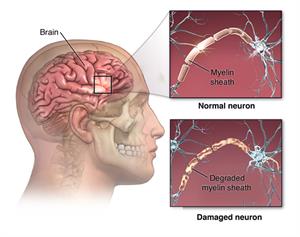
What is neuromyelitis optica?
Neuromyelitis optica (NMO) is a rare autoimmune disease that affects the central nervous system. It’s also called Devic’s disease. NMO specifically affects the myelin, which is the insulation around the nerves. NMO mainly affects the spinal cord and the optic nerves—the nerves that carry signals from the eyes to the brain. As a result, the disease can cause paralysis and blindness.
NMO most often strikes between the ages of 30 and 39. But it can also start during childhood. It can also affect adults who are in their 40s. It’s especially common in young women, but men can develop it, too.
Experts used to think that NMO was a type of multiple sclerosis. They now think it may be a different condition. The conditions do have some similar symptoms. But they are usually more severe in NMO. Vision problems with multiple sclerosis usually affect 1 eye at a time, while NMO may affect both eyes at the same time.
There are 2 types of NMO:
- Relapsing form, which has periodic flare-ups, with some recovery in between. This is the more common kind. Women are far more likely to have this form than men.
- Monophasic form, which involves a single attack that lasts a month or 2. Men and women get this type equally.
What causes neuromyelitis optica?
With NMO, your immune system attacks a substance in your body called myelin—the insulation around your nerves. Specifically, the myelin cells in the spinal cord and optic nerves are attacked. Usually, people with NMO have flare-ups of the disease that may strike months or years apart. Between these flare-ups, people may have some recovery.
Living with neuromyelitis optica
Disability from NMO may become worse over time. Most people with NMO develop weakness in their arms and legs. Others may have more severe symptoms. Some people with NMO need to start using a ventilator. This is a machine that helps them breathe. They may also need to work with an occupational therapist or social worker to address their disabilities.
If you or a family member is diagnosed with NMO, it is important to build a support system that includes family, friends, professionals, and support groups. A person with major disabilities may need the support of neurologists who specialize in NMO, occupational therapists, physical therapists, and social services professionals.







